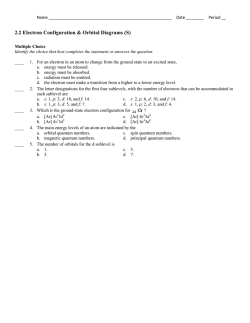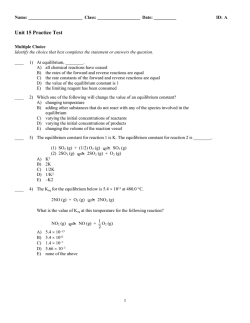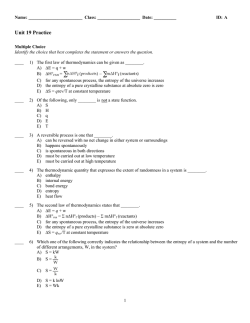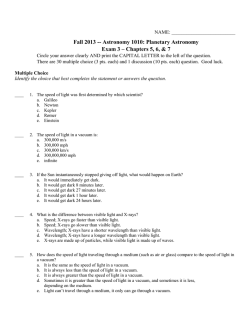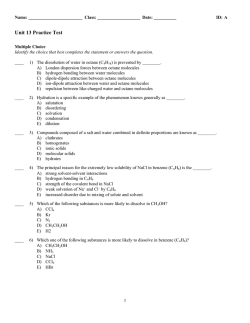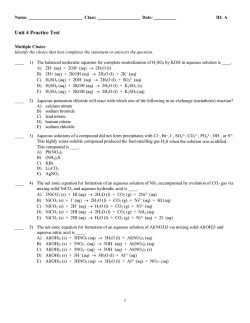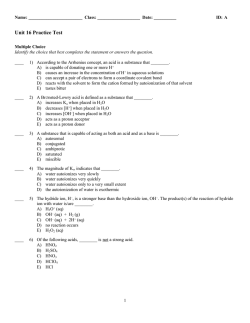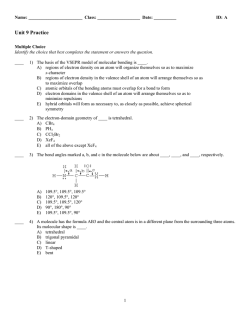
ExamView - ch 9-10 practice test.tst
Name: ________________________ Class: ___________________ Date: __________ Chapter 9-10 practice test Multiple Choice Identify the choice that best completes the statement or answers the question. ____ 1. Which one of the following is most likely to be an ionic compound? A. CaCl2 B. CO2 C. CS2 D. SO2 ____ 2. Which one of the following is most likely to be an ionic compound? A. ClF3 B. FeCl3 C. NH3 D. PF3 ____ 3. Which one of the following is most likely to be a covalent compound? A. Rb2O B. BaO C. SrO D. SeO2 ____ 4. Which one of the following is most likely to be a covalent compound? A. KF B. CaCl2 C. SF4 D. Al2O3 ____ 5. Which one of the following compounds utilizes both ionic and covalent bonding? A. CO32B. Al2(SO4)3 C. CO2 D. C6H12O6 ____ 6. The Lewis dot symbol for the chloride ion is A. – B. C. D. – – 1 ID: A Name: ________________________ ID: A 7. Which of the following ionic solids would have the largest lattice energy? A. KF B. KI C. LiF D. LiI ____ 8. Which of the following solids would have the highest melting point? A. NaF B. NaCl C. NaBr D. NaI ____ 9. Which of the following solids would have the lowest melting point? A. KI B. KBr C. KCl D. KF ____ 10. Use the Born-Haber cycle to calculate the lattice energy of KCl(s) given the following data: ____ H(sublimation) K = 79.2 kJ/mol I1 (K) = 418.7 kJ/mol Bond energy (Cl–Cl) = 242.8 kJ/mol EA (Cl) = 348 kJ/mol H (KCl(s)) = –435.7 kJ/mol –165 kJ/mol 288 kJ/mol 629 kJ/mol 707 kJ/mol ____ 11. Use the Born-Haber cycle to calculate the standard enthalpy of formation (H ) for LiCl(s) given A. B. C. D. the following data: H(sublimation) Li = 155.2 kJ/mol I1 (Li) = 520 kJ/mol Bond energy (Cl–Cl) = 242.7 kJ/mol EA (Cl) = 349 kJ/mol Lattice energy (LiCl(s)) = 828 kJ/mol A. 440 kJ/mol B. 320 kJ/mol C. –260 kJ/mol D. –380 kJ/mol ____ 12. Which of the elements listed below would most likely form a polar covalent bond when bonded to oxygen? A. Mg B. H C. Al D. O 2 Name: ________________________ ID: A ____ 13. Which of the elements listed below would most likely form a nonpolar covalent bond when bonded ____ 14. ____ 15. ____ 16. ____ 17. ____ 18. to bromine? A. Rb B. Br C. C D. O Define electronegativity: A. an atoms ability to attract electrons that are shared in a chemical bond B. an atoms ability to form an ionic bond with another atom C. an atoms ability to donate valence electrons to another atom D. an atoms ability to form a cation Arrange the elements C, O, and H in order of increasing electronegativity A. C < O < H B. H < C < O C. C < H < O D. O < C < H Which one of these polar covalent bonds would have the greatest percent ionic character? A. H — Br B. H — Cl C. H — F D. H — I What type of chemical bond holds the atoms together within a water molecule? A. Ionic bond B. Nonpolar covalent bond C. Polar covalent bond D. Coordinate covalent bond List all types of bonding present in the compound CaCO3 I. ionic bond II. polar covalent bond III. nonpolar covalent bond I only II only III only I and II ____ 19. The total number of valence electrons in the compound NH4NO3 is A. 28 B. 30 C. 32 D. 42 A. B. C. D. 3 Name: ________________________ ID: A ____ 20. The total number of valence electrons in the ion NH4+ is A. 8 B. 9 C. 10 D. 17 ____ 21. The number of lone electron pairs in the N2 molecule is ___. A. 1 B. 2 C. 3 D. 4 ____ 22. The Lewis structure reveals a triple bond in which of the following molecules? A. Br2 B. O2 C. N2 D. H2 ____ 23. The Lewis structure reveals an unpaired electron (free radical) in which of the following species? A. NO3B. N2O C. NO2 D. NO2____ 24. The number of lone electron pairs in the NH4+ ion is ___. A. 0 B. 1 C. 2 D. 3 ____ 25. The number of lone electron pairs in the ClO4- ion is ___. A. 3 B. 4 C. 6 D. 12 ____ 26. The number of resonance structures for the sulfur dioxide molecule that satisfy the octet rule is A. 1 B. 2 C. 3 D. 4 ____ 27. The number of resonance structures for the nitrate ion that satisfy the octet rule is A. 1 B. 2 C. 3 D. 4 4 Name: ________________________ ID: A ____ 28. The azide ion, N3–, is very reactive although it is isoelectronic with the very stable CO 2 molecule. ____ 29. ____ 30. ____ 31. ____ 32. ____ 33. ____ 34. This reactivity is reasonable considering that A. a Lewis structure cannot be written for the azide ion that has nitrogen formal charges of zero. B. there is no valid Lewis structure possible for the azide ion. C. there are resonance structures for azide ion but not for carbon dioxide. D. nitrogen cannot form multiple bonds. Assuming the octet rule is obeyed, how many covalent bonds will a nitrogen atom form to give a formal charge of zero? A. 0 B. 1 C. 2 D. 3 What is the formal charge on the oxygen atom in N2O (the atomic order is N–N–O)? A. -2 B. -1 C. 0 D. +1 How many covalent bonds will be drawn to bromine in BrO3– for the dot structure that expands the octet to minimize formal charge and if necessary places negative formal charges on the most electronegative atom(s). A. 3 B. 4 C. 5 D. 6 How many covalent bonds will be drawn to phosphorous in PO43– for the dot structure that expands the octet to minimize formal charge and if necessary places negative formal charges on the most electronegative atom(s). A. 4 B. 5 C. 6 D. 7 The formal charge on the sulfur atom in the resonance structure of sulfur dioxide which has one single bond and one double bond is A. -2 B. -1 C. 0 D. +1 What is the formal charge on sulfur in the most favorable Lewis structure for the SCN– (thiocyanate) ion based on minimizing formal charge overall? A. -2 B. -1 C. 0 D. +1 5 Name: ________________________ ID: A ____ 35. Nitrous oxide, N2O, is sometimes called “laughing gas”. What is the formal charge on the central ____ 36. ____ 37. ____ 38. ____ 39. ____ 40. nitrogen atom in the most favorable Lewis structure for nitrous oxide based on minimizing formal charge overall? (The atom connectivity is N–N–O.) A. –2 B. –1 C. 0 D. +1 What is the formal charge on the central nitrogen atom in the most favorable Lewis structure for the fulminate ion, CNO–, based on minimizing formal charge overall? A. +2 B. +1 C. 0 D. –1 BeF42– is called the fluoberyllate ion. The formal charge on the beryllium atom in this ion is A. –2 B. –1 C. 0 D. +1 For which of these species does the best Lewis structure have two or more equivalent resonance structures? A. HCO2– B. SCN– C. CNO– D. N3– Estimate the enthalpy change for the combustion of one mole of acetylene, C2H2, to form carbon dioxide and water vapor. BE(C–H) = 456 kJ/mol BE(CC) = 962 kJ/mol BE(O=O) = 499 kJ/mol BE(C=O) = 802 kJ/mol BE(O–H) = 462 kJ/mol A. +1010 kJ/mol B. +653 kJ/mol C. –155 kJ/mol D. –1010 kJ/mol The standard enthalpy of formation of ammonia at 25°C is –46.3 kJ/mol. Estimate the N–H bond enthalpy at this temperature. (Given: BE(NN)=941.4 kJ/mol, BE(H–H) = 436.4 kJ/mol) A. 360 kJ/mol B. 383 kJ/mol C. 391 kJ/mol D. 459 kJ/mol 6 Name: ________________________ ID: A ____ 41. Give the number of lone pairs around the central atom and the molecular geometry of IF5. A. 0 lone pairs, square pyramidal B. 0 lone pairs, trigonal bipyramidal C. 1 lone pair, square pyramidal D. lone pair, octahedral ____ 42. Give the number of lone pairs around the central atom and the geometry of the ion ClO3–. A. 0 lone pairs, trigonal B. 1 lone pair, bent C. 2 lone pairs, T-shaped D. 1 lone pair, trigonal pyramidal ____ 43. According to the VSEPR theory, the geometry of the SO3 molecule is A. pyramidal. B. tetrahedral. C. seesaw D. trigonal planar. ____ 44. The correct hybridization for CS2 molecule is best described as A. sp B. sp3 C. sp3d2 D. sp3d ____ 45. The correct hybridization for boron trichloride is A. sp B. sp2 C. sp3 D. sp3d ____ 46. According to the VSEPR theory, the molecular geometry of ammonia is A. linear B. trigonal pyramidal C. bent D. tetrahedral ____ 47. According to VSEPR theory, which one of the following molecules is trigonal bipyramidal? A. PF5 B. XeF4 C. NF3 D. SF6 ____ 48. Which one of the following molecules has tetrahedral geometry? A. XeF4 B. BF3 C. AsF5 D. CF4 7 Name: ________________________ ID: A ____ 49. Predict the geometry around the central atom in SO42–. A. trigonal planar B. trigonal pyramidal C. trigonal bipyramidal D. tetrahedral ____ 50. Which of the following substances is/are bent? (i) H2S (ii). CO2 (iii) ClNO (iv) NH2– (v) O3 A. only (iii) B. (i) and (v) C. (i), (ii), (iii), and (v) D. (i), (iii), (iv) and (v) ____ 51. A molecule with 3 single bonds and 1 lone pair of electrons around the central atom is predicted to have what type of molecular geometry? A. Tetrahedral B. Trigonal pyramidal C. Trigonal bipyramidal D. Bent ____ 52. A central atom with 4 electron pairs (single bonds and/or lone pairs of electrons) could have which of the following molecular geometries? I. Trigonal bipyramidal II. Tetrahedral III. Trigonal pyramidal IV. Bent I and II II and III II, III, and IV I and IV ____ 53. The bond angles in SCl2 are expected to be A. a little less than 109.5°. B. 109.5° C. a little more than 109.5°. D. 120°. ____ 54. Which of the following molecules has polar bonds but is a nonpolar molecule? A. PCl3 B. NCl3 C. BF3 D. HF ____ 55. Which of the following molecules has polar bonds but is a nonpolar molecule A. CO B. CO2 C. CHCl3 D. Cl2 A. B. C. D. 8 Name: ________________________ ID: A ____ 56. Which one of the following molecules is polar? A. PBr5 B. CCl4 C. BrF5 D. XeF2 ____ 57. Predict the geometry and polarity of the CS2 molecule. A. linear, polar B. linear, nonpolar C. tetrahedral, nonpolar D. bent, nonpolar ____ 58. Which of the following species has the largest dipole moment (i.e., is the most polar)? A. CH4 B. CH3Br C. CH3Cl D. CH3F ____ 59. Which of the following species have the same geometries? A. NH2– and H2O B. NH2– and BeH2 C. H2O and BeH2 D. NH2–, H2O, and BeH2 ____ 60. Give the number of lone pairs around the central atom and the molecular geometry of CBr4. A. 0 lone pairs, square planar B. 0 lone pairs, tetrahedral C. 1 lone pair, trigonal bipyramidal D. 1 lone pair, square pyramidal ____ 61. Give the number of lone pairs around the central atom and the molecular geometry of XeF2. A. 0 lone pairs, linear B. 1 lone pair, bent C. 3 lone pairs, linear D. 2 lone pairs, bent ____ 62. The geometry of the SF4 molecule is A. seesaw B. trigonal pyramidal. C. square planar. D. trigonal planar. ____ 63. Use VSEPR theory to predict the geometry of the PCl3 molecule. A. linear B. bent C. trigonal planar D. trigonal pyramidal 9 Name: ________________________ ID: A ____ 64. According to the VSEPR theory, which one of the following species is linear? A. H2S B. HCN C. BF3 D. H2CO ____ 65. According to VSEPR theory, which one of the following species has a tetrahedral geometry? A. IF4+ B. IF4– C. PCl4+ D. PCl4– ____ 66. Predict the geometry around the central atom in PO43–. A. trigonal planar B. trigonal pyramidal C. trigonal bipyramidal D. tetrahedral ____ 67. A central atom with 5 electron pairs (single bonds and/or lone pairs of electrons) could have which of the following molecular geometries? I. Trigonal bipyramidal II. Seesaw III. T-shaped IV. Linear I, II, and III II, III, and IV I, II, III and IV I, III, and IV ____ 68. The F –Cl –F bond angles in ClF3 are expected to be approximately A. 90° and 180°. B. 109.5° only. C. 180° only. D. 120° only. ____ 69. The C–N–O bond angle in nitromethane, CH3NO2, is expected to by approximately A. 60° B. 90° C. 109.5° D. 120° ____ 70. Which one of the following molecules is nonpolar? A. NH3 B. BeCl2 C. CH3Cl D. H2O A. B. C. D. 10 Name: ________________________ ID: A ____ 71. Which one of the following molecules has a non-zero dipole moment? A. BeCl2 B. Br2 C. BF3 D. IBr ____ 72. Which one of the following molecules has a zero dipole moment? A. CO B. CH2Cl2 C. SO3 D. SO2 ____ 73. Which of the following species has the largest dipole moment (i.e., is the most polar)? A. H2 B. H2O C. H2S D. H2Se Short Answer 1. Use VSEPR theory to predict the molecular geometry of CO32–. 2. According to VSEPR theory, which of the following triatomic ions should be linear: N 3–, I3–, NO2–, ClO2–, SCN–. 3. Using periodic trends, arrange the following molecules in order of increasing dipole moment: NH 3, PH3, AsH3. 4. Explain why CO2 is nonpolar, but OCS is polar. 5. Which of the following molecules has polar bonds but is a nonpolar molecule? PCl5, PCl3, NCl3 and CO2 6. According to the VSEPR theory, the geometrical structure of PF5 is 7. Draw a Lewis structure for PF5 that shows the correct atom arrangement predicted by VSEPR theory. 8. How does the geometrical structure of PF5 differ from that of IF5? 9. Ozone (O3) is an allotropic form of oxygen. Use VSEPR theory to predict the shape of the ozone molecule. 11 ID: A Chapter 9-10 practice test Answer Section MULTIPLE CHOICE 1. ANS: OBJ: 2. ANS: OBJ: 3. ANS: OBJ: 4. ANS: OBJ: 5. ANS: OBJ: 6. ANS: OBJ: 7. ANS: OBJ: 8. ANS: OBJ: 9. ANS: OBJ: 10. ANS: OBJ: 11. ANS: OBJ: 12. ANS: OBJ: 13. ANS: OBJ: 14. ANS: OBJ: 15. ANS: OBJ: 16. ANS: OBJ: 17. ANS: OBJ: 18. ANS: OBJ: 19. ANS: OBJ: 20. ANS: OBJ: 21. ANS: OBJ: A EK.2.C.2 B EK.2.C.2 D EK.2.C.1 C EK.2.C.1 B EK.2.C.1 B EK.2.C.4 C EK.2.C.2 A EK.2.C.1 A EK.2.C.1 D EK.5.C.2 D EK.5.C.2 B EK.2.C.1 B EK.2.C.1 A EK.2.C.1 B EK.2.C.1 C EK.2.C.1 C EK.2.C.1 D EK.2.C.1 C EK.2.C.4 A EK.2.C.4 B EK.2.C.4 PTS: 1 DIF: Easy REF: Section: 9.2 PTS: 1 DIF: Easy REF: Section: 9.2 PTS: 1 DIF: Easy REF: Section: 9.4 PTS: 1 DIF: Easy REF: Section: 9.4 PTS: 1 DIF: Medium REF: Section: 9.4 PTS: 1 DIF: Medium REF: Section: 9.2 PTS: 1 DIF: Medium REF: Section: 9.3 PTS: 1 DIF: Medium REF: Section: 9.3 PTS: 1 DIF: Medium REF: Section: 9.3 PTS: 1 DIF: Difficult REF: Section: 9.3 PTS: 1 DIF: Difficult REF: Section: 9.3 PTS: 1 DIF: Medium REF: Section: 9.5 PTS: 1 DIF: Medium REF: Section: 9.5 PTS: 1 DIF: Easy REF: Section: 9.5 PTS: 1 DIF: Medium REF: Section: 9.5 PTS: 1 DIF: Medium REF: Section: 9.5 PTS: 1 DIF: Medium REF: Section: 9.5 PTS: 1 DIF: Medium REF: Section: 9.5 PTS: 1 DIF: Medium REF: Section: 9.6 PTS: 1 DIF: Medium REF: Section: 9.6 PTS: 1 DIF: Medium REF: Section: 9.6 1 ID: A 22. ANS: OBJ: 23. ANS: OBJ: 24. ANS: OBJ: 25. ANS: OBJ: 26. ANS: OBJ: 27. ANS: OBJ: 28. ANS: OBJ: 29. ANS: OBJ: 30. ANS: OBJ: 31. ANS: OBJ: 32. ANS: OBJ: 33. ANS: OBJ: 34. ANS: OBJ: 35. ANS: OBJ: 36. ANS: OBJ: 37. ANS: OBJ: 38. ANS: OBJ: 39. ANS: OBJ: 40. ANS: OBJ: 41. ANS: OBJ: 42. ANS: OBJ: 43. ANS: OBJ: 44. ANS: OBJ: 45. ANS: OBJ: C EK.2.C.4 C EK.2.C.4 A EK.2.C.4 D EK.2.C.4 B EK.2.C.4 C EK.2.C.4 A EK.2.C.4 D EK.2.C.4 B EK.2.C.4 C EK.2.C.4 B EK.2.C.4 D EK.2.C.4 C EK.2.C.4 D EK.2.C.4 B EK.2.C.4 A EK.2.C.4 A EK.2.C.4 D EK.5.C.2 C EK.5.C.2 C EK.2.C.4 D EK.2.C.4 D EK.2.C.4 A EK.2.C.4 B EK.2.C.4 PTS: 1 DIF: Medium REF: Section: 9.6 PTS: 1 DIF: Medium REF: Section: 9.6 PTS: 1 DIF: Medium REF: Section: 9.6 PTS: 1 DIF: Medium REF: Section: 9.6 PTS: 1 DIF: Difficult REF: Section: 9.8 PTS: 1 DIF: Difficult REF: Section: 9.8 PTS: 1 DIF: Difficult REF: Section: 9.7 PTS: 1 DIF: Medium REF: Section: 9.7 PTS: 1 DIF: Difficult REF: Section: 9.7 PTS: 1 DIF: Difficult REF: Section: 9.9 PTS: 1 DIF: Difficult REF: Section: 9.9 PTS: 1 DIF: Difficult REF: Section: 9.7 PTS: 1 DIF: Difficult REF: Section: 9.7 PTS: 1 DIF: Difficult REF: Section: 9.7 PTS: 1 DIF: Difficult REF: Section: 9.7 PTS: 1 DIF: Medium REF: Section: 9.7 PTS: 1 DIF: Medium REF: Section: 9.8 PTS: 1 DIF: Difficult REF: Section: 9.10 PTS: 1 DIF: Difficult REF: Section: 9.10 PTS: 1 DIF: Medium REF: Section: 10.1 PTS: 1 DIF: Medium REF: Section: 10.1 PTS: 1 DIF: Medium REF: Section: 10.1 PTS: 1 DIF: Medium REF: Section: 10.1 PTS: 1 DIF: Medium REF: Section: 10.1 2 ID: A 46. ANS: OBJ: 47. ANS: OBJ: 48. ANS: OBJ: 49. ANS: OBJ: 50. ANS: OBJ: 51. ANS: OBJ: 52. ANS: OBJ: 53. ANS: OBJ: 54. ANS: OBJ: 55. ANS: OBJ: 56. ANS: OBJ: 57. ANS: OBJ: 58. ANS: OBJ: 59. ANS: OBJ: 60. ANS: OBJ: 61. ANS: OBJ: 62. ANS: OBJ: 63. ANS: OBJ: 64. ANS: OBJ: 65. ANS: OBJ: 66. ANS: OBJ: 67. ANS: OBJ: 68. ANS: OBJ: 69. ANS: OBJ: B EK.2.C.4 A EK.2.C.4 D EK.2.C.4 D EK.2.C.4 D EK.2.C.4 B EK.2.C.4 C EK.2.C.4 A EK.2.C.4 C EK.2.C.1 B EK.2.C.1 C EK.2.C.1 B EK.2.C.1 D EK.2.C.1 A EK.2.C.4 B EK.2.C.4 C EK.2.C.4 A EK.2.C.4 D EK.2.C.4 B EK.2.C.4 C EK.2.C.4 D EK.2.C.4 C EK.2.C.4 A EK.2.C.4 D EK.2.C.4 PTS: 1 DIF: Medium REF: Section: 10.1 PTS: 1 DIF: Medium REF: Section: 10.1 PTS: 1 DIF: Medium REF: Section: 10.1 PTS: 1 DIF: Medium REF: Section: 10.1 PTS: 1 DIF: Medium REF: Section: 10.1 PTS: 1 DIF: Medium REF: Section: 10.1 PTS: 1 DIF: Medium REF: Section: 10.1 PTS: 1 DIF: Medium REF: Section: 10.1 PTS: 1 DIF: Medium REF: Section: 10.2 PTS: 1 DIF: Medium REF: Section: 10.2 PTS: 1 DIF: Medium REF: Section: 10.2 PTS: 1 DIF: Medium REF: Section: 10.2 PTS: 1 DIF: Medium REF: Section: 10.2 PTS: 1 DIF: Medium REF: Section: 10.1 PTS: 1 DIF: Medium REF: Section: 10.1 PTS: 1 DIF: Medium REF: Section: 10.1 PTS: 1 DIF: Medium REF: Section: 10.1 PTS: 1 DIF: Medium REF: Section: 10.1 PTS: 1 DIF: Medium REF: Section: 10.1 PTS: 1 DIF: Medium REF: Section: 10.1 PTS: 1 DIF: Medium REF: Section: 10.1 PTS: 1 DIF: Medium REF: Section: 10.1 PTS: 1 DIF: Medium REF: Section: 10.1 PTS: 1 DIF: Medium REF: Section: 10.1 3 ID: A 70. ANS: OBJ: 71. ANS: OBJ: 72. ANS: OBJ: 73. ANS: OBJ: B EK.2.C.1 D EK.2.C.1 C EK.2.C.1 B EK.2.C.1 PTS: 1 DIF: Medium REF: Section: 10.2 PTS: 1 DIF: Medium REF: Section: 10.2 PTS: 1 DIF: Medium REF: Section: 10.2 PTS: 1 DIF: Medium REF: Section: 10.2 DIF: Medium REF: Section: 10.1 SHORT ANSWER 1. ANS: trigonal planar PTS: 1 OBJ: EK.2.C.4 2. ANS: N3–, I3–, and SCN– are linear PTS: 1 OBJ: EK.2.C.4 3. ANS: DIF: Medium REF: Section: 10.1 DIF: Medium REF: Section: 10.2 AsH3 < PH3 < NH3 PTS: 1 OBJ: EK.2.C.1 4. ANS: In CO2 the two bond moments point in opposite directions and are of equal magnitude. Therefore, they cancel. In OCS, even though the two bond moments point in opposite directions, they are not of the same magnitude and do not cancel. PTS: 1 OBJ: EK.2.C.1 5. ANS: DIF: Medium REF: Section: 10.2 DIF: Medium REF: Section: 10.2 PCl5 and CO2 PTS: 1 OBJ: EK.2.C.1 6. ANS: trigonal bipyramidal PTS: 1 OBJ: EK.2.C.4 DIF: Medium REF: Section: 10.1 4 ID: A 7. ANS: PTS: 1 OBJ: EK.2.C.4 8. ANS: DIF: Medium REF: Section: 10.1 PF5 is trigonal bipyramidal, whereas IF5 is square pyramidal PTS: 1 OBJ: EK.2.C.4 9. ANS: DIF: Medium REF: Section: 10.1 DIF: Medium REF: Section: 10.1 Bent PTS: 1 OBJ: EK.2.C.4 5
© Copyright 2025
